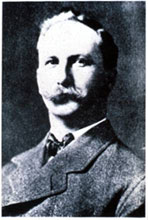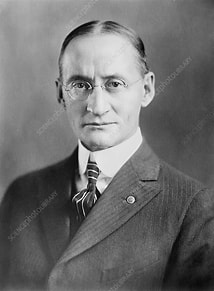1904 It was on one May evening that former Canadian mountie, John E. Kennedy, sent a note to the head of Lord and Thomas.

John E. Kennedy joins Lord and Thomas
This is what the note looked like:

Ambrose Thomas, the head of Lord and Thomas, dismissed the note as arrogance. But his junior partner, Albert Lasker, spotted it and wanted to know more.
This was Lasker’s reply:

Lasker met Kennedy that first evening. And what Kennedy had to say changed the face of advertising – and it still applies today.
His statement was: “Advertising is Salesmanship-in-Print.” It is a definition that no-one has been able to better to this day.
| Time-out: Here’s my understanding of “Salesmanship-in-Print” There is no difference between ads, websites, newsletters, brochures, press releases, or being sat in front of your Customers – face-to-face. And to succeed at selling in print it is necessary to study others that have made a living at it, past and present. 98% of marketers have no idea of how to sell in print. Therefore, study direct response marketers. They are the only ones who can prove what works. Direct Marketing, by definition, is a method that sells its products without sales people. It is always measurable. And the top direct marketers do measure it. To succeed you need to make your sales process do the same as if you were sat right next to your Customers. Your website, sales letter, press release, newsletter, brochure, or anything else in print has to connect with your prospects’ emotional hot buttons to persuade him or her to take some sort of action. Your advertising should not be about ‘image’ or ‘branding’, it should be about telling your own unique story in a language that appeals to your prospects needs, wants, desires, fears and vanity. |
Lasker related to what Kennedy talked about. He too had been searching for many years to the answer that Kennedy had now given him.
Consequently, Kennedy was hired by Lord and Thomas and became the highest paid copywriter of the time. A massive $52,000 a year (some say even more).
Lord and Thomas became a training ground for copywriters as Lasker got Kennedy to write all of his principles into a series of lessons called: “The Book of Advertising Tests.”
Kennedy left Lord and Thomas in 1907 but returned in 1911 as a highly paid freelance copywriter. And in 1912 his Book of Advertising Tests was re-published as: “Reason Why Advertising” and in 1914 he wrote his second book: “Intensive Advertising.”
|
Time-out:  Reason Why Advertising But lots of advertisers, even today, do not. They merely say: “Buy my product.” |
1903 Walter Dill Scott produces his first book: “Theory of Advertising.”

Professor Walter Dill Scott was lecturer at North Western University

0 Comments